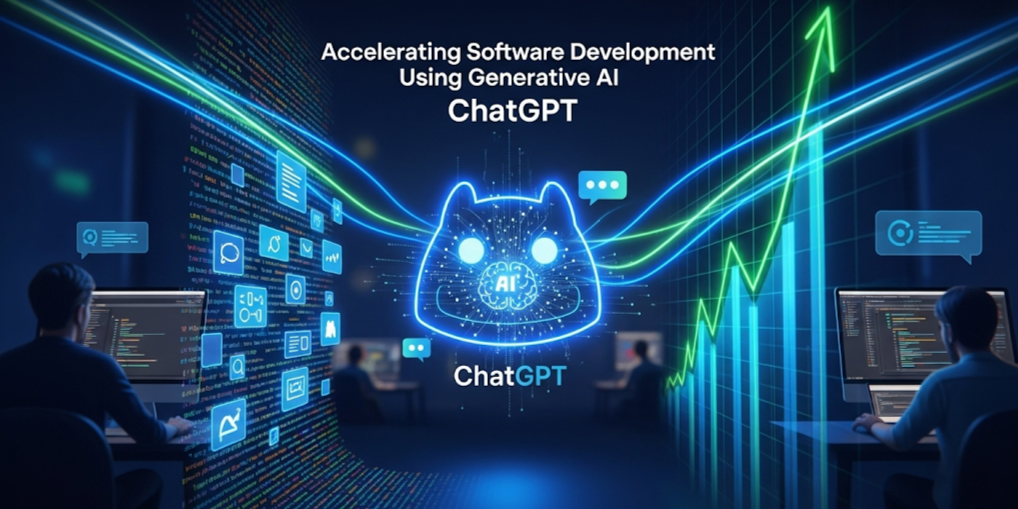In the fast-paced world of software development, time is critical, and efficiency is everything. Developers are under constant pressure to deliver high-quality products quickly. That’s where generative AI, particularly ChatGPT, steps in. This powerful AI model has revolutionized how software development is approached by automating time-consuming tasks like coding, debugging, documentation, and more.
In this case study, we’ll explore how generative AI is accelerating the software development lifecycle and the benefits it brings to development teams, from speed to quality.
How Generative AI ChatGPT Accelerates Software Development
Generative AI tools, such as ChatGPT, are transforming traditional software development practices. Let’s look at the main ways they streamline development processes.
1. Automated Code Generation
One of the most significant advantages of using generative AI in software development is automated code generation. Developers can input a problem statement or a high-level description of what they want to achieve, and ChatGPT can generate the corresponding code. This can significantly speed up the process, especially for repetitive tasks such as creating boilerplate code or implementing common functions.
Example: If a developer needs a function to sort a list in Python, ChatGPT can quickly generate the code with minimal input. This reduces the time spent writing routine code from scratch.
2. Enhanced Code Review and Debugging
Finding and fixing bugs can be one of the most tedious and time-consuming aspects of development. Generative AI models like ChatGPT can analyze code, identify issues, and suggest fixes. Instead of manually reviewing thousands of lines of code, developers can use AI to pinpoint potential problems, improving accuracy and reducing review time.
Example: AI can scan a large codebase, detect deprecated functions, and suggest modern alternatives. It can also highlight performance bottlenecks and offer optimization tips.
3. Streamlined Documentation
Documentation is often neglected or takes up a large chunk of time in software development. ChatGPT can assist by automatically generating detailed documentation, API descriptions, and even inline comments in the code. With AI, developers can focus on coding while ChatGPT handles the documentation.
Example: After writing a function, a developer can ask ChatGPT to generate a description of how the function works and what parameters it accepts, creating user-friendly documentation in a fraction of the time.
4. Faster Unit Testing
AI tools like ChatGPT can help generate unit tests based on the code. These tests can ensure that the software functions as expected, reducing the time developers spend creating tests manually.
Example: Once a developer completes a function, they can ask ChatGPT to generate test cases that check for edge cases or specific inputs, ensuring higher code reliability.
Tools and Benefits of Using Generative AI in Software Development
To understand the full scope of how generative AI like ChatGPT can benefit your software development projects, here’s a comparison table of some tools and their benefits:
| Tool | Benefit |
|---|---|
| ChatGPT | Automated code generation, bug detection, documentation creation, unit test generation. |
| Codex by OpenAI | AI for writing code in multiple programming languages, fine-tuned for development tasks. |
| GitHub Copilot | Real-time code suggestions, completion, and error fixes while writing code in IDEs. |
| Tabnine | AI-powered code completion that integrates directly into IDEs to enhance developer productivity. |
Benefits of Generative AI:
-
Increased speed: Automates repetitive coding tasks, reducing time spent on manual tasks.
-
Higher accuracy: Reduces human error by detecting bugs and suggesting fixes in real-time.
-
Cost savings: Reduces the need for additional human resources for routine tasks like documentation and code review.
-
Improved collaboration: With better documentation and AI-generated code suggestions, teams can collaborate more effectively.
Real-World Case Studies
Case Study 1: E-Commerce Platform Development
An e-commerce company looking to streamline its development process turned to generative AI to help build and maintain its platform. By using ChatGPT, the team automated the generation of product listings, implemented new features faster, and reduced the time spent on debugging by 30%. Additionally, the AI-generated unit tests helped ensure that new features were thoroughly tested before deployment, reducing errors in production.
Case Study 2: Mobile App Development for a Healthcare Provider
A healthcare provider working on a mobile app to manage patient data integrated ChatGPT for documentation and unit testing. The AI quickly generated API documentation and test cases, which significantly shortened the time to launch. This allowed the development team to focus on enhancing the app’s features while maintaining high standards of quality assurance.
Challenges and Considerations
While generative AI offers many benefits, there are also some challenges to consider:
-
Accuracy of suggestions: Sometimes, the code generated by AI might not be optimized or may require manual adjustments.
-
Over-reliance on AI: Developers may become overly reliant on AI tools, which could lead to a lack of understanding of the underlying code or concepts.
-
Security concerns: AI models might introduce security risks if they are not properly fine-tuned to avoid vulnerabilities in the generated code.
Conclusion: Harnessing AI for Faster, More Efficient Software Development
Generative AI tools like ChatGPT are reshaping the software development landscape. By automating routine tasks like code generation, debugging, and documentation, developers can focus more on innovation and less on mundane tasks. With the right tools and mindset, software teams can leverage AI to accelerate development cycles, improve code quality, and reduce costs.
Call to Action: Ready to speed up your software development? Start experimenting with generative AI tools like ChatGPT and see how they can transform your workflow today!








Leave a Reply